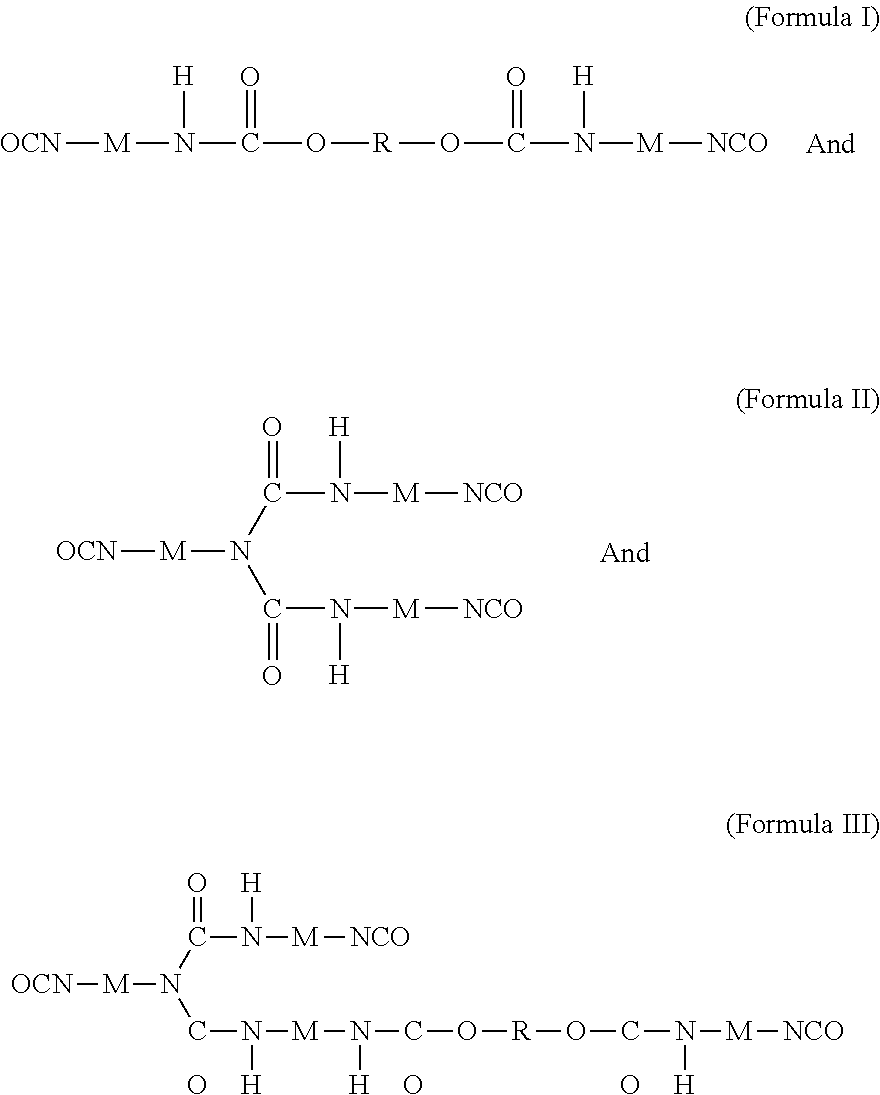Modified Diphenylmethane Diisocyanate (MDI) Biuret Curing Agent and Preparation Method Thereof
- Summary
- Abstract
- Description
- Claims
- Application Information
AI Technical Summary
Benefits of technology
Problems solved by technology
Method used
Image
Examples
first embodiment
[0060]a, 125 g of MDI-100 (i.e. pure 4,4′-MDI), 125 g of MDI-50 (i.e. a mixture of 4, 2′-MDI occupying a weight of 50%, and 4,4′-MDI occupying a weight of 50%) and 80 g of n-butyl acetate are added into a reaction kettle, stirred uniformly, and reacted with 24.5 g of dehydrated tricyclic diol for 0.5 h at a room temperature, heated up to 60° C. and reacted for 2.5 hours at 65˜75° C. to obtain an MDI-modified product;
[0061]b, the temperature is lowered to 70° C., and 1.1 g of water is added for the first time, reacted for 1.5 hours at 70˜80° C., heated up to 120˜130° C. and reacted for 1 hour; then the temperature is lowered to 80° C., and 1.1 g of water is added for the second time, reacted for 0.5 hour at 80˜90° C., heated up to 120˜130° C. and reacted for 0.5 hour; then the temperature is lowered to 80° C., and 1.1 g of water is added for the third time, reacted for 0.5 hour at 80˜90° C., heated up to 120˜130° C. and reacted for 0.5 hour; then the temperature is lowered to 80° C.,...
second embodiment
[0066]a, 125 g of MDI-100, 125 g of MDI-50 and 76 g of n-butyl acetate are added into a reaction kettle, stirred uniformly, and reacted with 4 g of dehydrated neopentyl glycol and 4 g of diglycol for 0.5 hour at a room temperature, heated up to 60° C. and reacted for 1.5 hours at 70˜80° C. to obtain an MDI-modified product;
[0067]b, the temperature is lowered to 70° C., and 1.2 g of water is added for the first time, reacted for 1 hour at 70˜80° C., heated up to 120˜130° C. and reacted for 0.5 hour; then the temperature is lowered to 80° C., and 1.2 g of water is added for the second time, reacted for 0.5 hour at 80˜90° C., heated up to 120˜130° C. and reacted for 0.5 hour; then the temperature is lowered to 80° C., and 1.2 g of water is added for the third time, reacted for 0.5 hour at 80˜90° C., heated up to 120˜130° C. and reacted for 0.5 hour; then the temperature is lowered to 80° C., and 1.2 g of water is added for the fourth time, reacted for 0.5 hour at 85˜95° C., heated up t...
third embodiment
[0069]a, 250 g of MDI-100 and 112 g of n-butyl acetate are added into a reaction kettle, stirred uniformly, and reacted with 90 g of dehydrated polyethylene adipate-ethylene glycol-propylene glycol diol (having a molecular weight of 600) for 1 hour at a room temperature, heated up to 60° C., reacted for 2 hours at 70˜80° C. to obtain an MDI-modified product;
[0070]b, the temperature is lowered to be under 70° C., and 1.0 g of water is added for the first time, reacted for 0.5 hour at 70˜80° C., heated up to 120˜130° C. and reacted for 0.5 hour; then the temperature is lowered to 70° C., and 1.0 g of water is added for the second time, reacted for 0.5 hour at 70˜80° C., heated up to 120˜130° C. and reacted for 0.5 hour; then the temperature is lowered to 70° C., and 1.0 g of water is added for the third time, reacted for 0.5 hour at 70˜80° C., heated up to 120˜130° C. and reacted for 0.5 hour; then the temperature is lowered to 90° C., and 1.0 g of water is added for the fourth time, ...
PUM
| Property | Measurement | Unit |
|---|---|---|
| Temperature | aaaaa | aaaaa |
| Temperature | aaaaa | aaaaa |
| Temperature | aaaaa | aaaaa |
Abstract
Description
Claims
Application Information
 Login to View More
Login to View More - R&D
- Intellectual Property
- Life Sciences
- Materials
- Tech Scout
- Unparalleled Data Quality
- Higher Quality Content
- 60% Fewer Hallucinations
Browse by: Latest US Patents, China's latest patents, Technical Efficacy Thesaurus, Application Domain, Technology Topic, Popular Technical Reports.
© 2025 PatSnap. All rights reserved.Legal|Privacy policy|Modern Slavery Act Transparency Statement|Sitemap|About US| Contact US: help@patsnap.com



